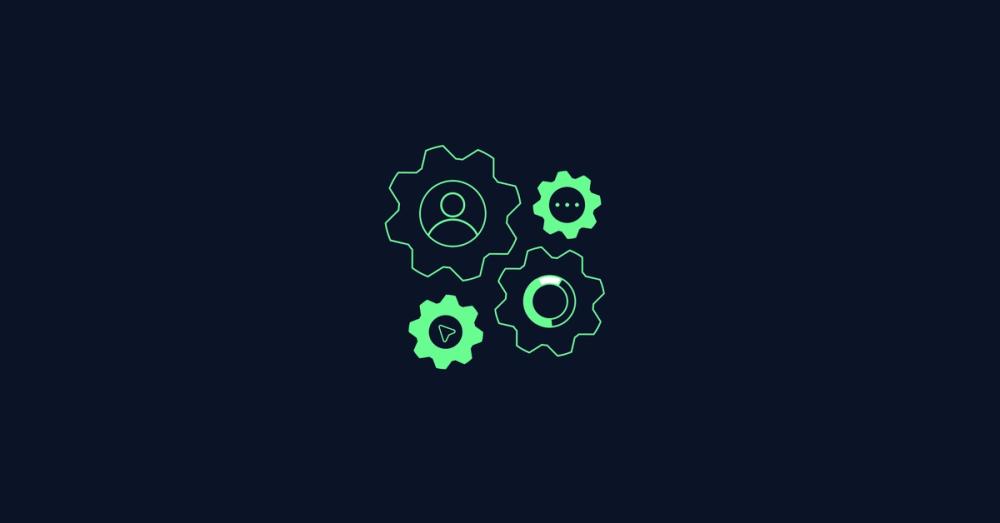Industry 5.0: The Quiet Revolution Making Tech Human Again
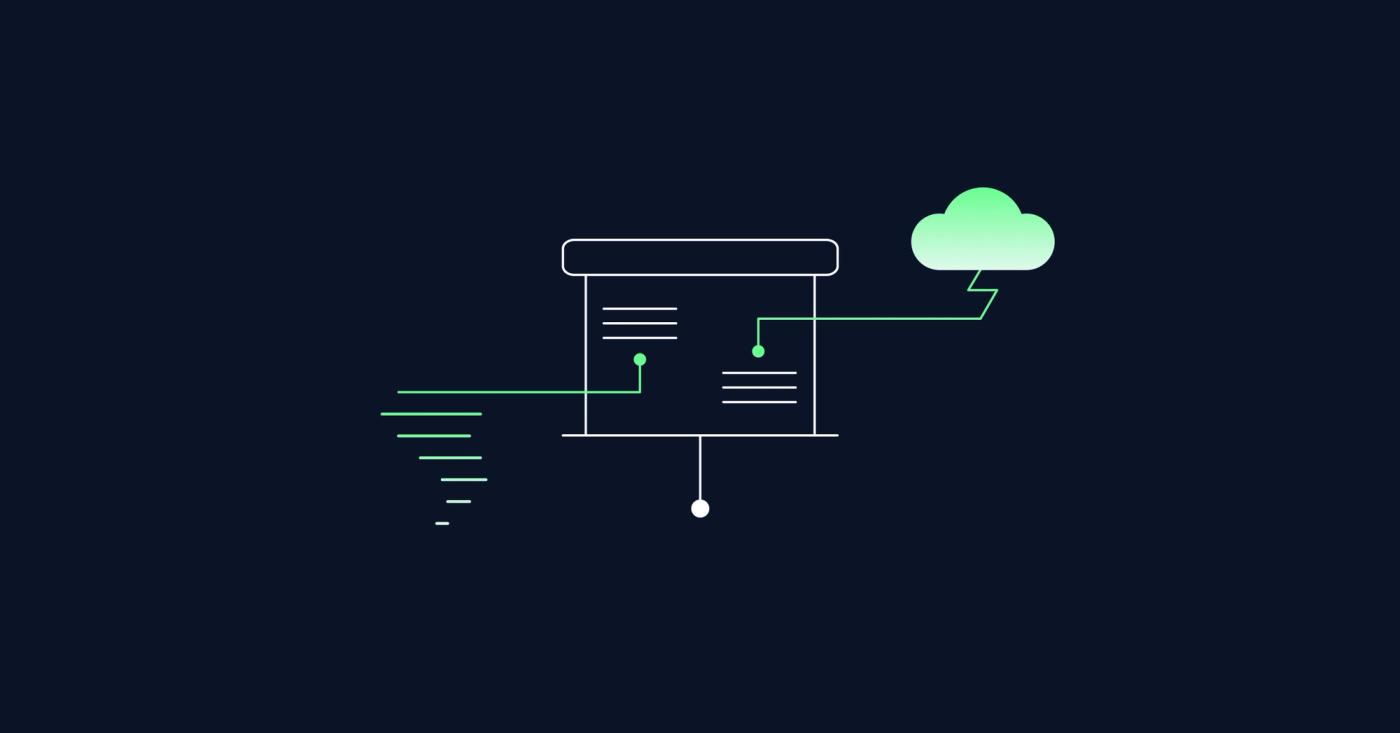
We live in dark and worrying times at the moment. Humanity made it through Covid and we all hoped things would improve after that but unfortunately the opposite is happening. The challenges we have to deal with individually and as a society become only more instead of less. It seems like we just can’t catch a break …
Two weeks ago the whole Dinghy crew attended the World Usability Congress 2025 in Graz, Austria which opened my eyes to a brighter future. Stephanie Weber, Head of UX Design @Fielmann AG shared a quote that struck me like lightning 🌩️. A profound insight that explains so many aspects of the apparent frustration we collectively hold when looking at the current state of the world.
Before I share this with you, let’s take it from the beginning.
The Last Decade: How We Got Here Link to this headline
The internet is around ~30-35 years old now (considering when dial-up modems started to become generally available in households).
Reflecting on the past 10-15 years of my professional career as designer, web developer and entrepreneur, working on digital products, I experienced first hand how advancements in the field were mostly driven by what’s possible — and not necessarily by what’s right for us humans.
New tech, more features, more capabilities, quicker development cycles and digital products ubiquitously weaved into our lives — at break-neck speeds on top of all that. No other industry developed so quickly ever before. I’m sure you’ve all seen a chart like this, showing vividly how technological advancements were seemingly adopted quicker and quicker:

In 2011 Germany coined the term “Industry 4.0 – smart factories, connected systems, efficiency, transparency, automation”.
And I think it fits the picture perfectly: Optimize everything for the machine, for production, for metrics — no mention of the word Human anywhere.
In user experience design we often discuss the premise of “dark UX patterns”. What’s meant by that are tactics to essentially trick people into taking an action. Those tactics were not necessarily born out of pure evil but rather out of legacy business KPIs.

As any other part of a business, design ultimately has to adhere to KPIs defined through business strategy. Most of the KPIs many companies use to this day stem from 1960-70s, the TV-era, when success metrics were defined as more of everything: Reach, frequency, exposure.
Today they’re just called a bit differently:
- Time Spent / Screen Time / Session Duration
- Views / Page Views / Impressions
- Total Reach / Follower Count / Subscriber Numbers
- Daily Active Users (DAU) Without Context
- Engagement Rate (Without Defining Engagement)
- Clicks / Downloads / Sign-ups
All these metrics share TV's fundamental flaw: they measure business outcomes (attention, reach, impressions) instead of user outcomes (success, satisfaction, goal achievement).
This fits the term definition of “Industry 4.0” very well. It’s all about the business and efficiency and inherently not about the human. By now we know that working towards these metrics can lead to quick success but need a lot of effort to keep running. “Users” (a.k.a us humans) need to be persuaded again and again to keep using digital products designed around those metrics.
Over time this looks like this:
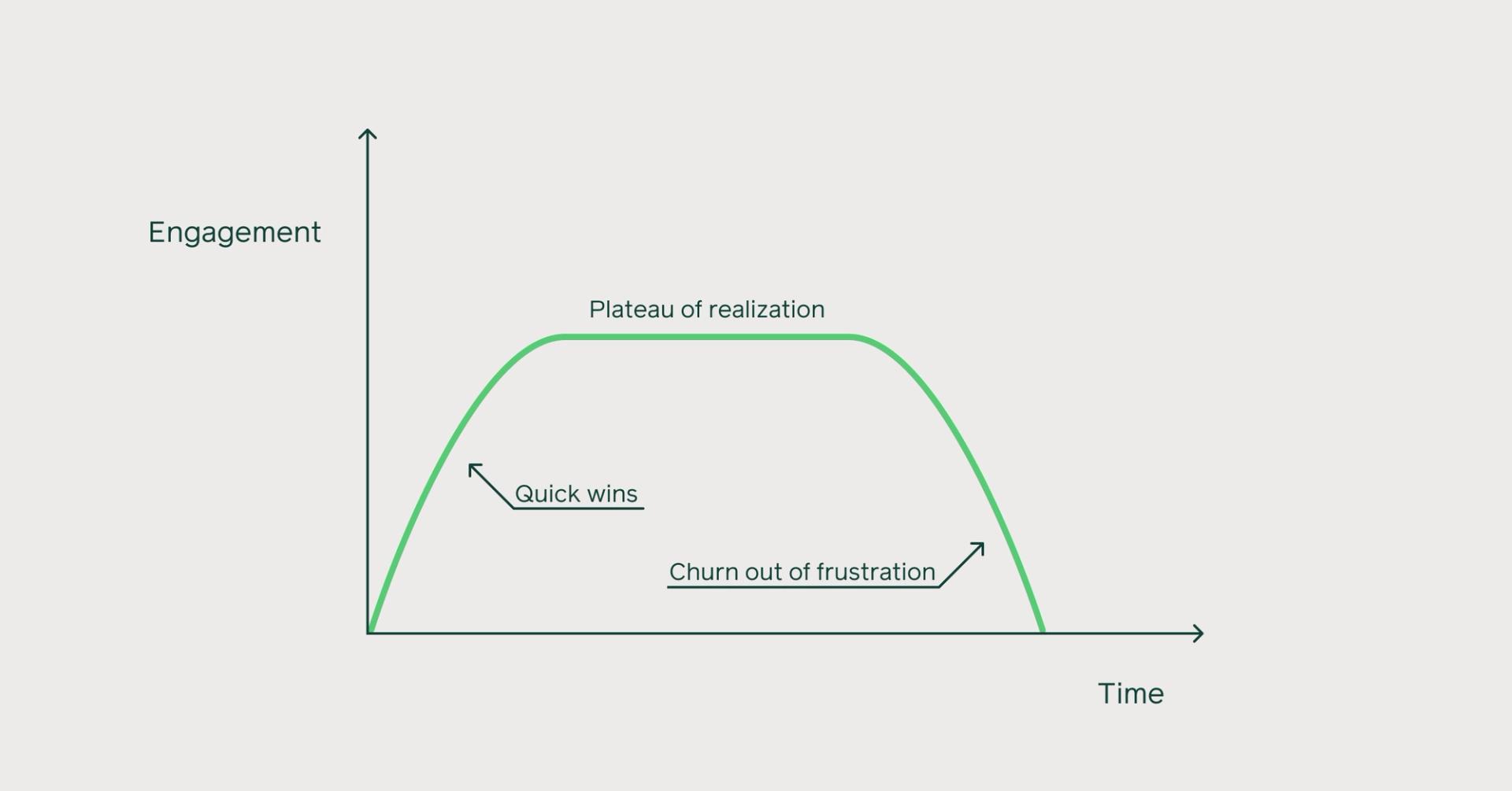
We also know that the outcome of these “tactics” (aka design adhering to legacy metrics set by business informed by outdated strategy) lead to erosion of trust, users retreating into their “fear castles,” feeling forgotten and bypassed.
At Dinghy we constantly discuss how to measure and surface the impact of good UX Design in business terms. But in an engineering-driven country like Germany, the technical and functional aspect of a product traditionally takes precedence over user needs. Design and Usability Research are often viewed as “nice-to-have”, optional and not “driving business success”.
Clients expect visible results as soon as possible and usually have little headspace to change the perspective into that of their customers. And it’s not even because they don’t want to. It’s mostly appreciated that we as the creatives try and take the perspective of their customers. It’s just that key stakeholders in projects usually have so many other things on their plate, that they have to prioritize — which usually means more implementation and less deliberate user experience design.
It appears as that we are all collectively incentivized to forget the human in all these equations.
Taking the neuro-scientific perspective Link to this headline
We all take many, many decision per day. Every second there’s a little something to decide. Most of those decisions are made through our emotion-driven subconscious. Only 5% of decisions are processed through our analytical, rational part of the brain.
And this exactly where the quote mentioned in the beginning comes in, that resonated so strongly with me:
Creativity happens, when curiosity is stronger than fear – Stephanie Weber, Fielmann AG
Those dark patterns in UX design exploit exactly this: Our emotions. Anxiety and fear (of missing out for example) are strong forces driving our decision making process. Humans are also hard-wired to fear the unknown because the unknown could potentially be harmful. And we have many unknowns going around currently, at a global scale!
All that leads to this downward spiral of an “equation”:

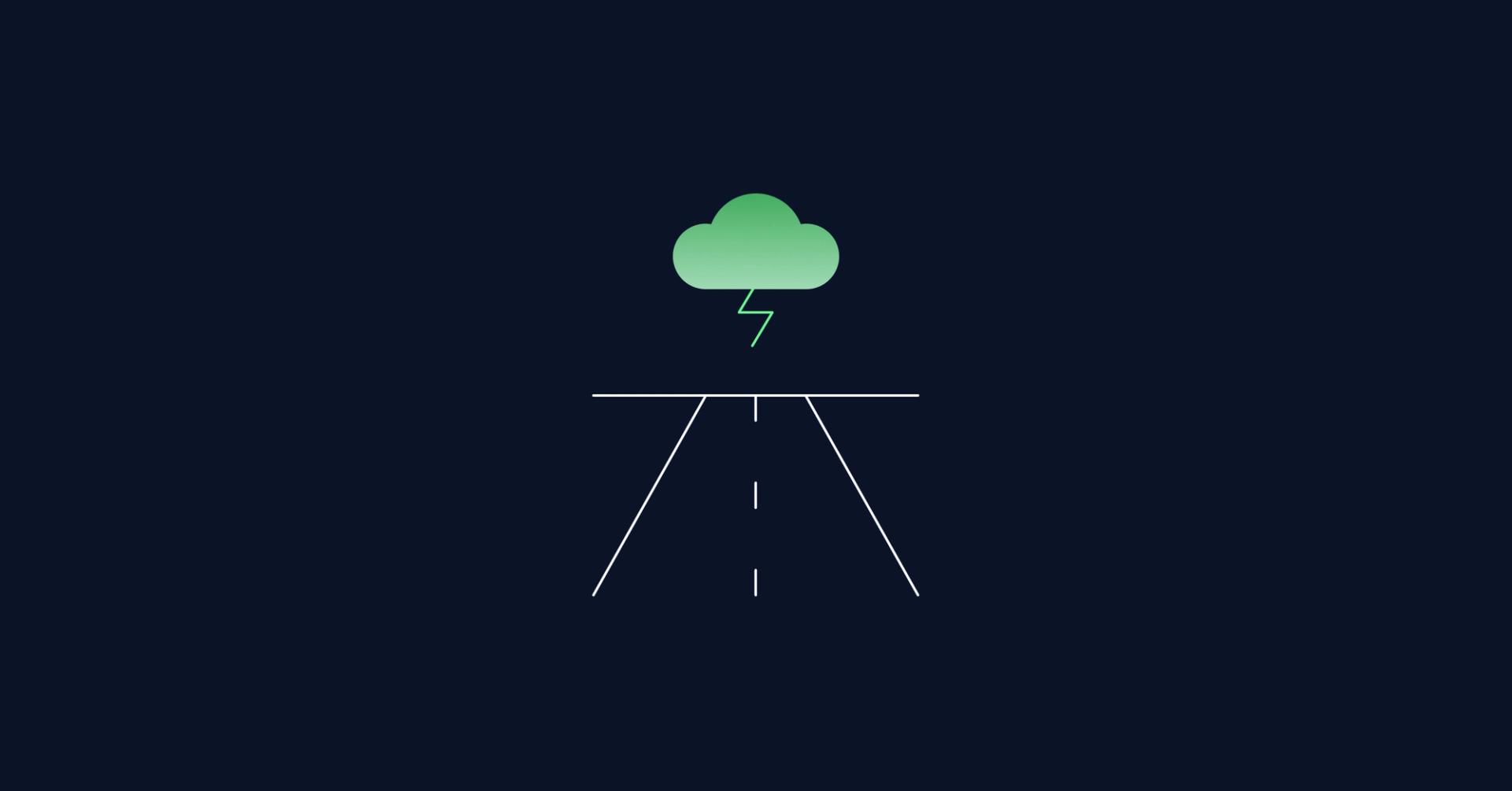
All that fear and bad decisions get exploited by populists, social media and big corporations for financial gain and political power… we see it on the news every day, there are more studies on the topic as I’m willing to count, it’s what creates our anxiety fueled bubbles currently.
Fear essentially drives us all to shut out facts more and more because the facts suggest bigger and bigger, life-threatening outcomes for us all, without a solution in sight — but to find good solutions, we direly need our collective creativity.
An beacon of hope: World Usability Congress 2025 Link to this headline
Last week the Dinghy crew spoke at and attended the World Usability Congress in Graz (my college Nosipho gave one of the opening talks of the conference, but that’s another story).
Looking at the agenda it stood out that almost half of all the talks were geared around the question of “How do we quantify the value of UX design in business terms?”.
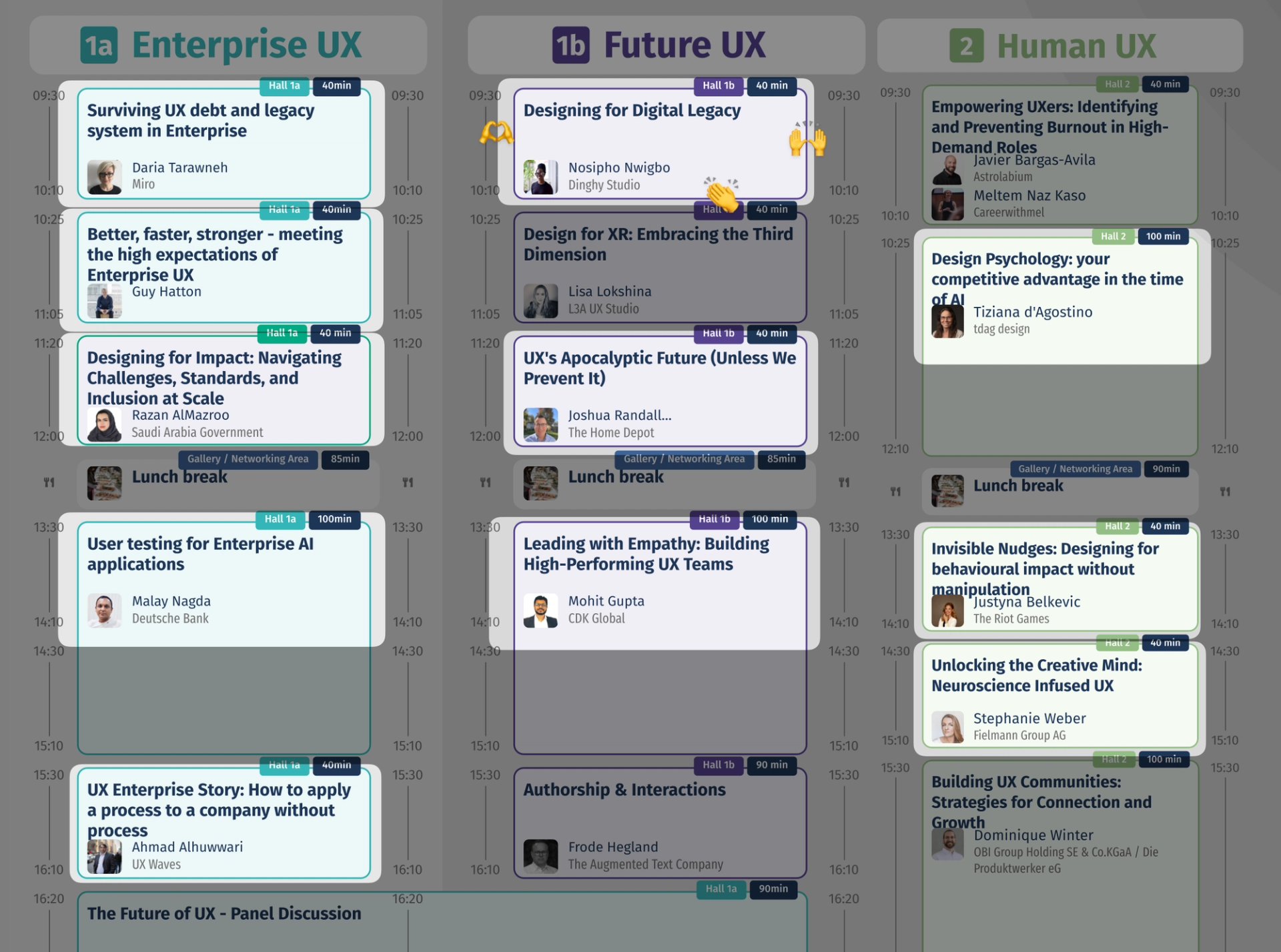
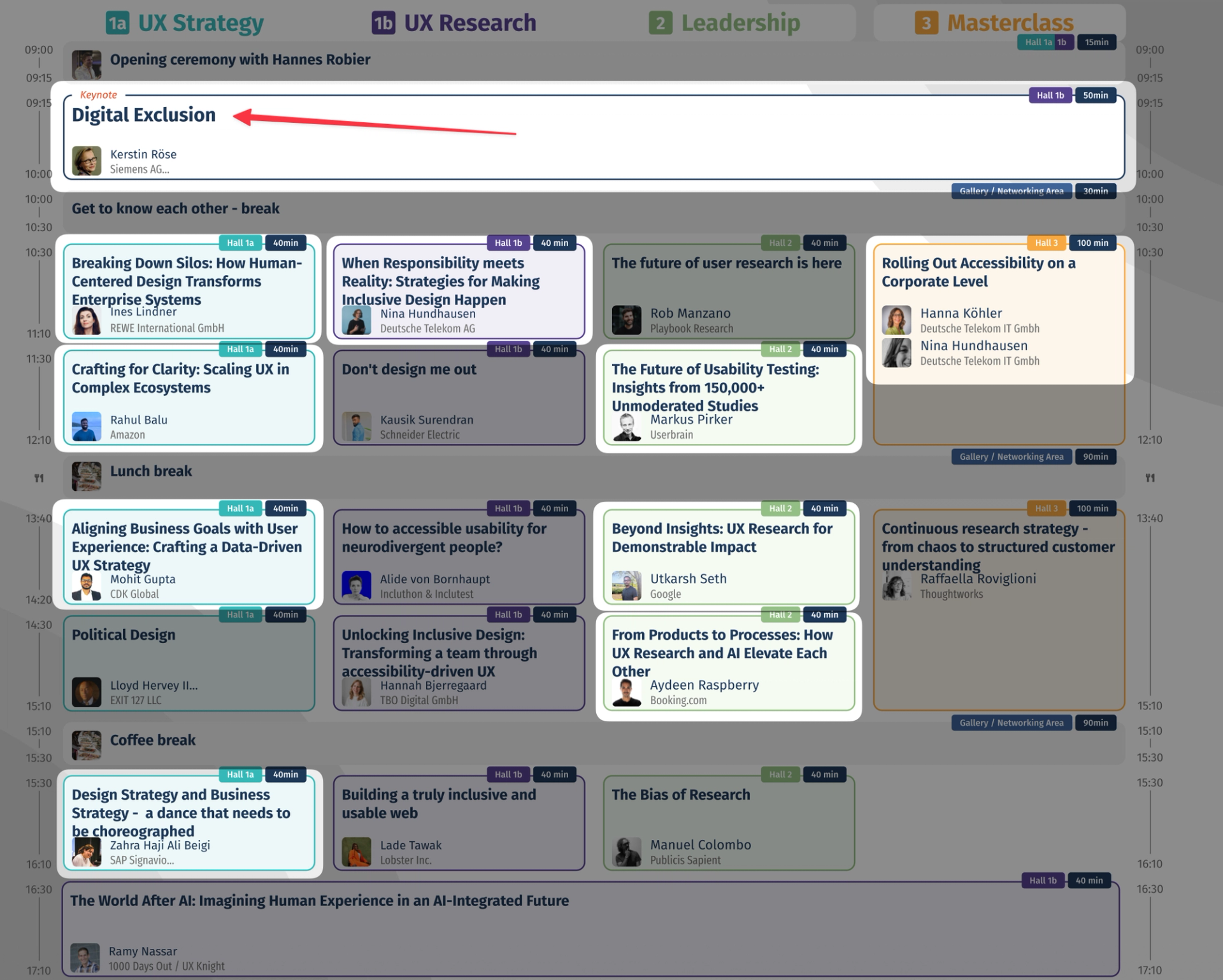
Those talks were not theoretical either, on a level where we as UX professionals still ask the question “how might we …?”; they presented evidence of actual, long term business success which was achieved through implementing human centered design practices throughout their organizations.
Both tech giants Amazon and Google shared stories that had simple and transparent language at their core. CDK Global, working in the automative industry and based in the US presented their system to connect business KPIs to user goals. And a little closer to home, we had Deutsche Telekom AG and Fielmann Group AG sharing success stories which had transparent and accessible design at their core.
Deutsche Telekom AG: Inclusion and Accessibility on a Corporate Level Link to this headline
Nina Hundhausen shared Telekom’s story of first facing the regulatory challenge of accessibility in all their digital and physical products. And second of how they then realized the massive opportunity for taking this much much further. As illustrated in Nina’s slide here, the further left/the earlier in the process you have a good and validated concept, the more effective and successful the implementation will be in end. This is why at Dinghy we pay much attention to the research and concept phase of projects, so that we’re confident in what’s going to be implemented.
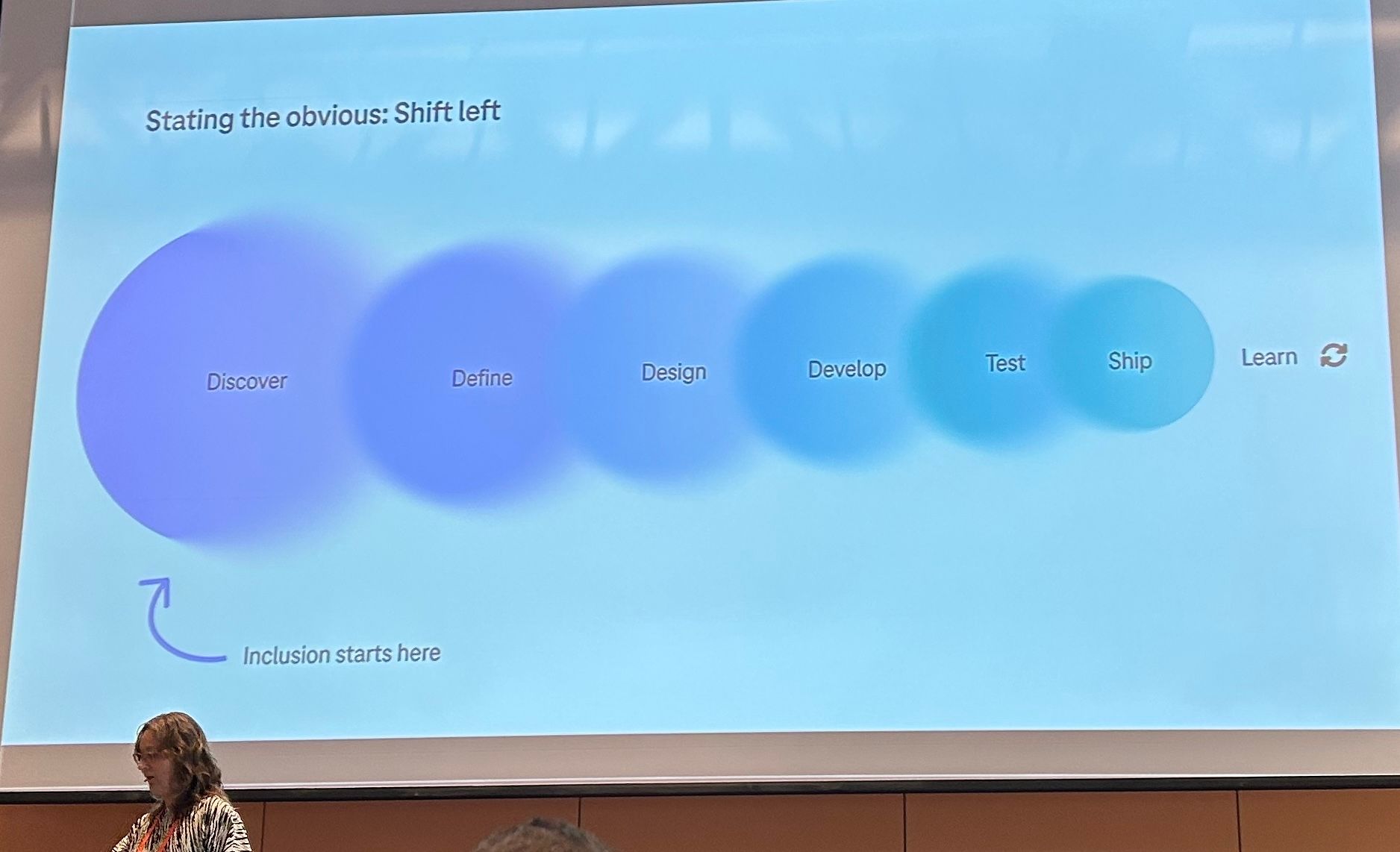
Fielmann Group AG: Northstar KPI “Customer Satisfaction” Link to this headline
Stephanie Weber’s talk made a very lasting impression on me. I want a t-shirt with this impactful quotes shared earlier: “Creativity happens when curiosity is stronger than fear.”
It’s just such a powerful sentence that encapsulates our current zeitgeist so well. She brought that up to surface how powerful it is to create an open and safe space for their design team, including all the neuro-spicyness of the world, to actually look beyond the usual Tellerrand and be creative without fear.
She shared an ice-breaker tactic I’m for sure going to try out during our next workshop:
“What’s the WORST possible solution for this problem?” – This actively drives out the fear of sharing a sub-par idea in the group and thus creates a safe space.
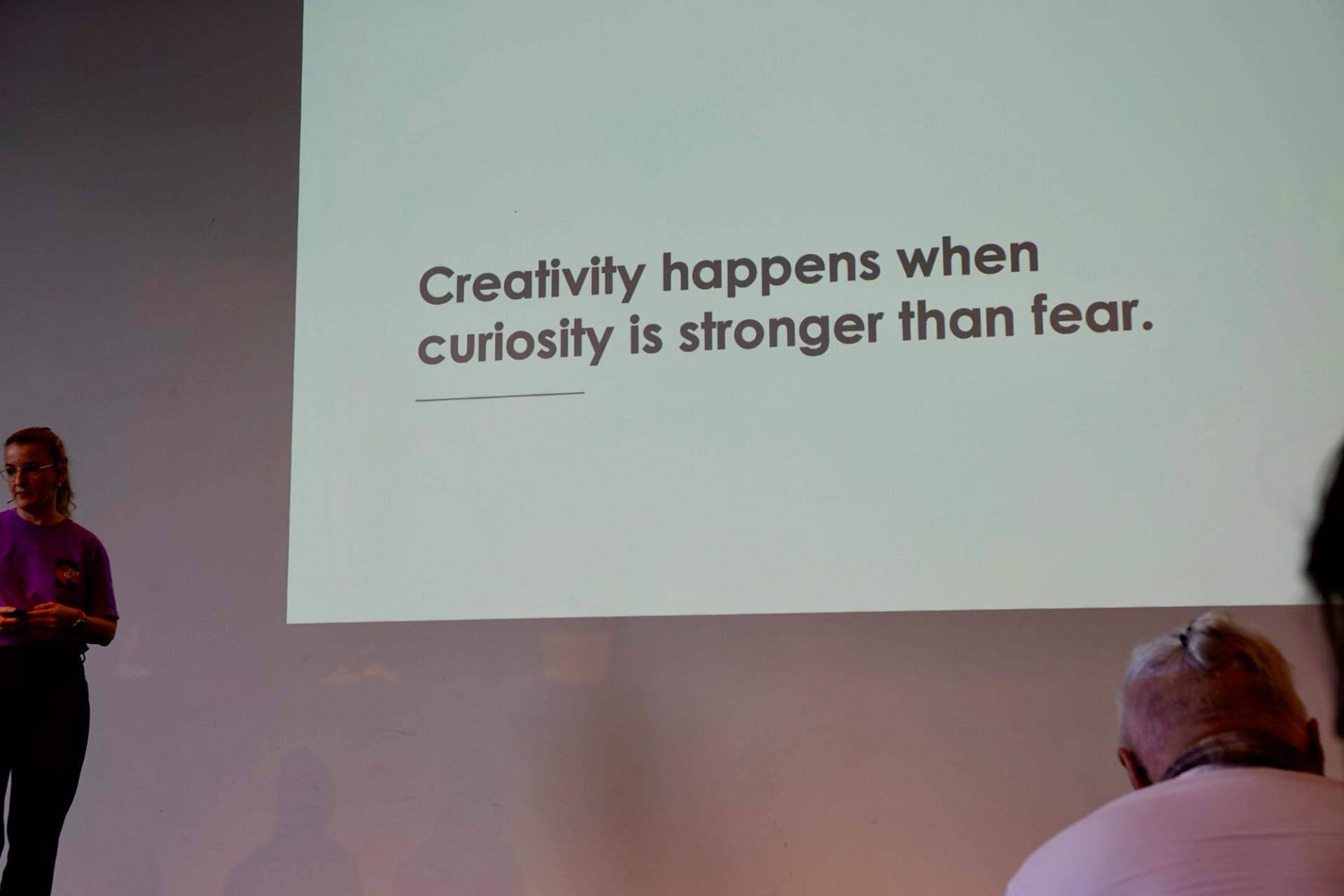
CDK Global: Aligning Business Goals with User Experience: Crafting a Data-Driven UX Strategy Link to this headline
Mohit Gupta from CDK Global (Automotive Industry) shared their approach of collaboration and emphasized the importance of common language and shared tools between different departments to make information and insights discoverable for everyone in the organization, leading to successful implementation of human centered design.
They keep intricate planning boards on Jira open to everyone in the organization and map high-level business goals all the way down to the individual user goals, defined in the persona itself.
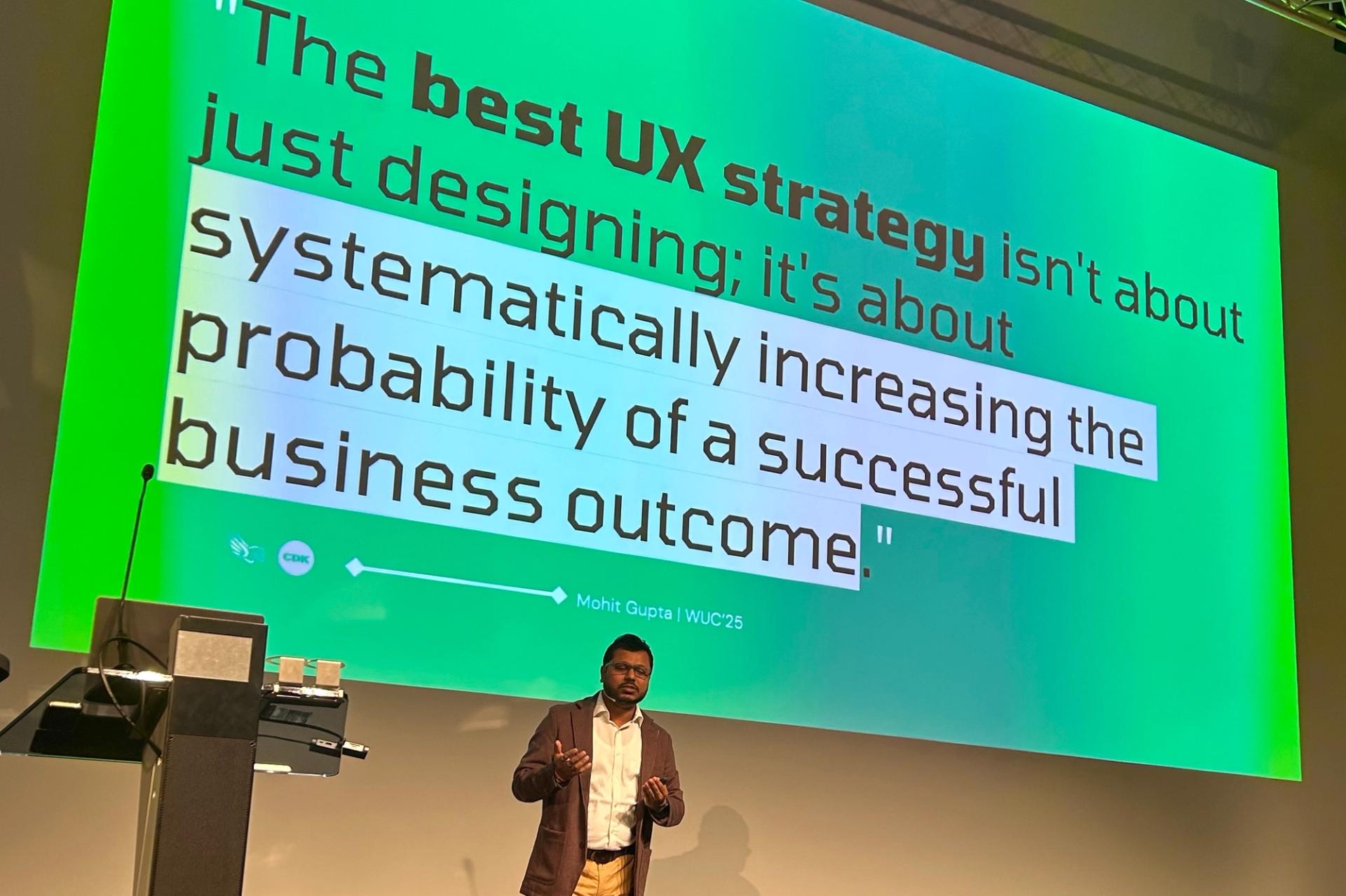
In one way or another all these talks shared success stories of long term business success from trust-building UX design. Let’s update our chart from before with now two graphs:
- Applying manipulative design tactics, a.k.a dark UX patterns
- Putting the customer’s interest first through human-centered design
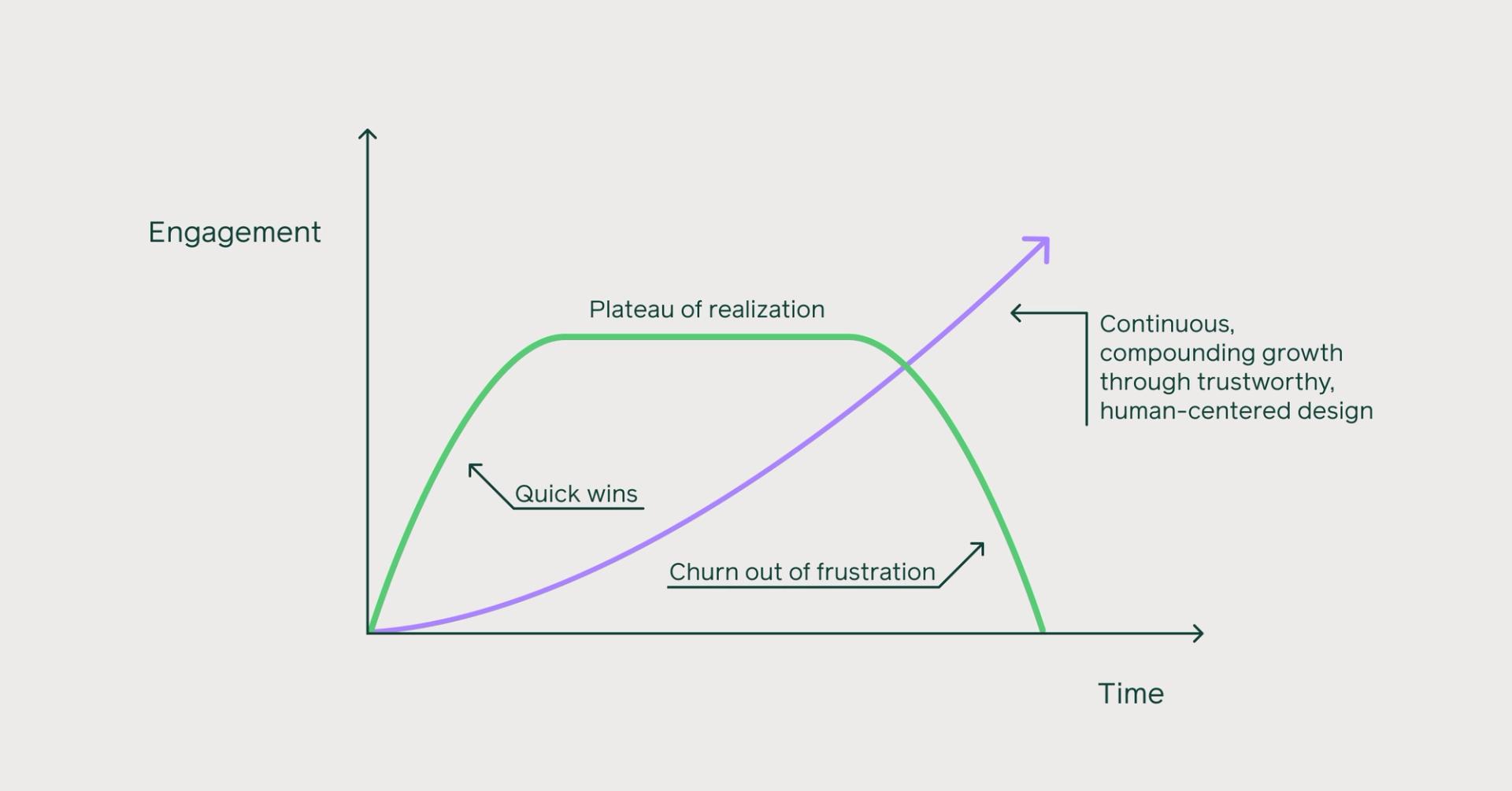
But that’s not all! Now let’s get to the actual kicker …
Industry 5.0: Putting Humans Back in the Center Link to this headline
Seeing so many cases where good UX directly led to business success was such a relief. It showed us that there’s a reward for advocating for ethical design and it’s not us fighting against a windmill.
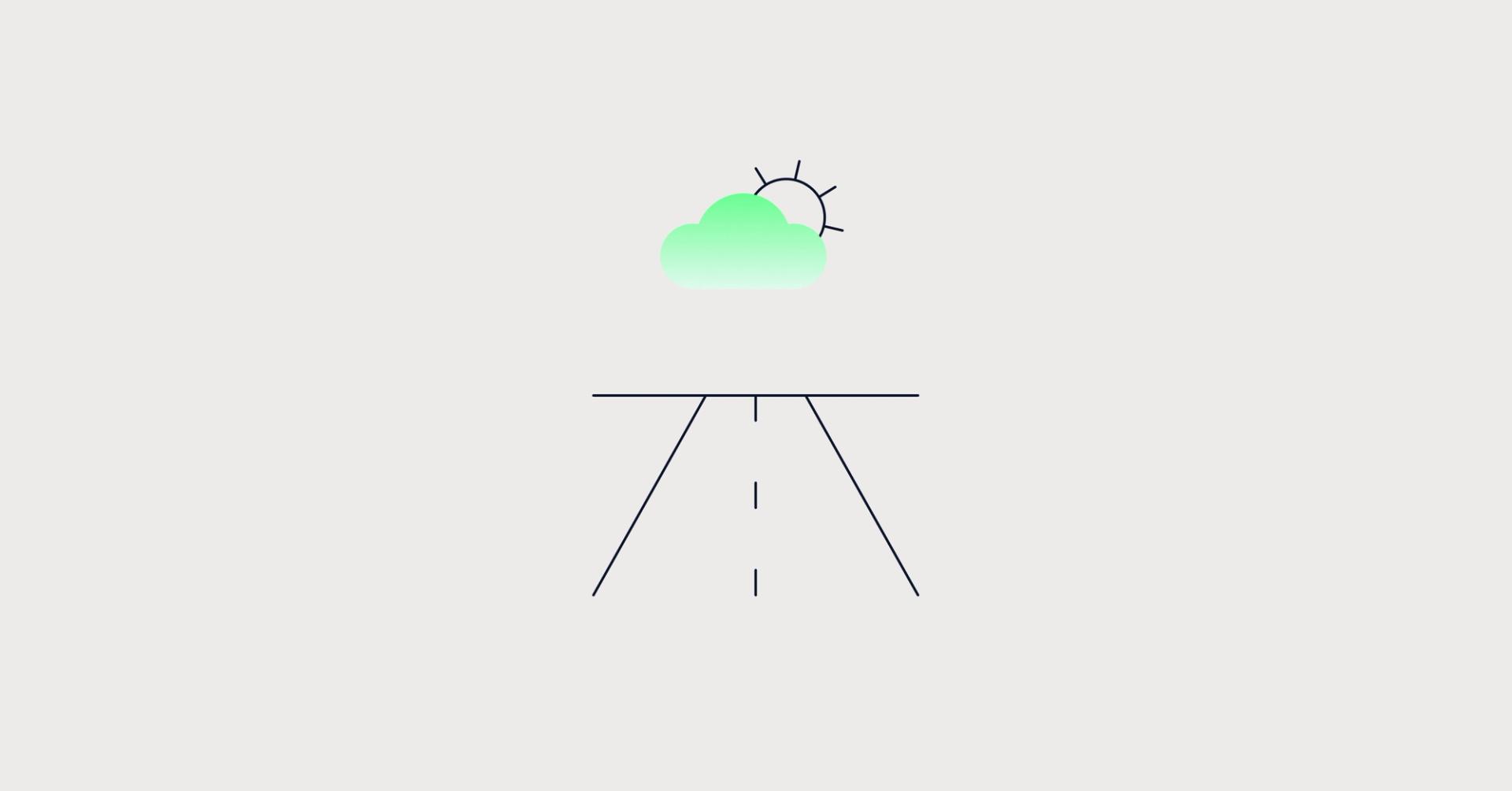
It’s not a niche success for a small group of organizations who are willing to “sacrifice” revenue for ethics either.
The opposite is the case when we now look at the definition of the 5th Industrial Revolution:

„People are deliberately placed at the center of the digital transformation […]“ — Kerstin Röse, Siemens AG
Let’s compare the two era definitions quickly:
- Industry 4.0: Machines, efficiency, connected systems, transparency in production
- Industry 5.0: Humans, well-being, sustainability, resilience, technology as support/assistance (not the goal itself)
Industry 5.0 is already here and it’s not a term made popular exclusively by designers. This term definition represents industry leaders aligning on a strategy for business success. A north star for the entire industry to navigate towards.
Why This Matters NOW Link to this headline
It’s easy to feel overwhelmed right now. Doomscrolling is almost a national sport, and the headlines rarely let up—war, climate, economy, polarization. If fear is the only lens we look through, it’s no wonder most of us default to “Netflix till a better time comes.”
But here’s the critical point: fear narrows our field of vision. Neurologically, we literally shut down the parts of our brain responsible for creativity, play, even basic curiosity.
If we want to solve any of our big problems — climate, social cohesion, an aging society — then we have to do more than just optimize for efficiency. We have to create environments (digital and physical) where people feel safe enough to be curious again.
Human-centered design isn’t just a better way to make apps; it’s an antidote for fear itself. When companies prioritize the lived needs and contexts of real people, trust builds. A design that signals “we see you, you matter”—through clarity, inclusivity, and respect—becomes a microcosm for broader societal trust.
The political dimension runs deep: the less people feel “seen,” the more vulnerable they are to stories that promise the safety of a return to the past, no matter how impossible. Industry 5.0’s focus on wellbeing, resilience, and the human as the center is a clear rejection of that nostalgia trap. In fact, it gives us a reason to believe in forward motion again.
Hope on an Industrial-Scale Link to this headline
With companies like Fielmann, Telekom, and Siemens showing that you can win by putting people first, the narrative is changing. We’re not talking about idealism anymore. We’re talking about measurable, repeatable business success — and a future-ready roadmap that doesn’t leave people behind.
When a movement becomes so thoroughly anchored in economic logic and human benefit, it’s hard not to believe in its trajectory. Industry 5.0 is not just rhetoric; it’s organizational North Star for companies large and small, already woven into strategic playbooks and product roadmaps across continents.
So, in all the dark headlines and instability, it’s worth remembering: there’s a powerful counter-movement in full swing, and every act of ethical design, every instance of clarifying language, every feature that genuinely helps… it all adds up.
The road ahead? It’s not about returning to the past, or racing blindly toward more tech for tech’s sake. It’s about harnessing everything we’ve learned, and setting a new direction — one where technology serves people, not the other way around.
Yes the future looks grim at the moment but I strongly believe we’ve just touched the first milestone of an era-change. Welcome to the future 🫶.

